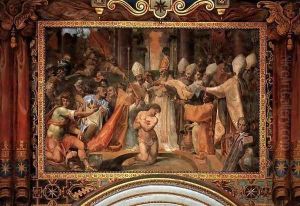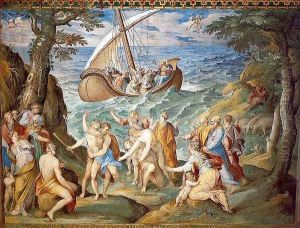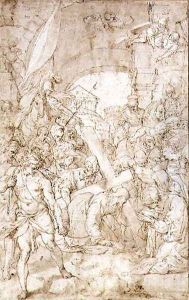Nicolo Circignani (Pomarancio) Paintings
Nicolo Circignani, commonly known by the nickname Pomarancio after his birthplace, Pomarance in Tuscany, was an Italian Mannerist painter active during the Renaissance. Born in 1530, he was a contemporary of many notable artists and contributed to the rich tapestry of 16th-century Italian art.
Pomarancio's early life is not extensively documented, but it is known that he trained as an artist and was heavily influenced by the Mannerist style, which was characterized by its artificial elegance, elongated figures, and often complex compositions that broke away from the balanced and harmonious works of the High Renaissance.
Throughout his career, Pomarancio was primarily active in Rome, where he was engaged in the decoration of several churches and buildings. His works often featured frescoes and altarpieces, and he was known for his ability to handle large-scale compositions. He worked on various projects in notable Roman churches such as San Lorenzo in Damaso, Santo Stefano Rotondo, and the Basilica di Santa Maria Maggiore.
One of his most famous works is the fresco cycle in the apse and dome of the cathedral in Orvieto, which depicts scenes from the Last Judgment. This ambitious project showcased his talent for creating dramatic, expressive figures and complex compositions that were typical of the Mannerist style.
Pomarancio's influence extended beyond his frescoes and included works on canvas and panel. He was an accomplished draftsman, and his drawings and preparatory sketches provide insight into his working methods and the development of his compositions.
Despite his achievements, Pomarancio's work was sometimes criticized for lacking the grace and subtlety of some of his more famous contemporaries, such as Michelangelo and Raphael. Nevertheless, his bold use of color, dramatic lighting effects, and the emotional intensity of his figures cemented his place in the art historical canon.
Nicolo Circignani, Pomarancio, died in 1588, leaving behind a legacy of work that continued to influence artists in the late Mannerist and early Baroque periods. His contributions to Italian art are remembered for their emblematic representation of the complex, often contradictory spirit of the late Renaissance era.


